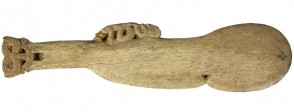It is important to encourage students to use the appropriate terminology when discussing these themes. The term exploration is preferable to discovery as it reminds students that they are viewing history from the European perspective and that these cultures had existed for thousands of years. You may want to discuss the different implications of these terms with students.
As an introductory activity, compare the clubs by focusing upon the visual evidence, for example, the form, decoration, material. Then, once certain features have been identified, for example, what looks like a handle, a hole, ask them to speculate about what they might be. Then show the details of the objects in For the classroom to identify the two strands of the story: Māori culture and Cook’s exploration.
Tell the students the story of Hine Te Ao, who received the wahaika club to introduce the idea of how important and powerful objects are. Ask them to research objects in the Te Papa museum collection - link in For the classroom. Discuss the different object types: weapons, bowls, clothing, jewellery and parts of houses. Each student should then choose a single object and write a short museum label. These can then be mounted on the classroom wall to create a display of taonga. Look also for images of these objects being used.
AD 1750 – 1800 was a time of great global activity. Create a timeline highlighting key global events between these years. Use the following headings for guidance: war, scientific discoveries, New Zealand history, voyages of exploration.
Divide the class into groups and ask them to research and write short biographies of the key characters in the story of these objects: Captain Cook; Tupaia; Joseph Banks; Omai. In each case they should find an image and also draw a map of their travels. Discuss with the class how critical each person’s contributions were in this era of global encounters.
Ask students to research how many days some of these voyages took. If you cannot find examples, estimate the times using the information about Cook’s voyages online. Make a bar chart with destinations on the x axis (include Amsterdam, New York, Cape Town, India, Cape Horn, New Zealand) and the days voyage on the y axis. These voyages were dangerous: have a class discussion about the dangers, which included getting lost (which could lead to a discussion about the need for navigation and understanding longitude), weather, pirates and mutiny, as in the case of HMS Bounty in 1789
Objects acquired by Cook have ended up in museums across Britain. Find out if any are in your local museum and try to visit. Find out as much as possible about the object: its original use and meaning to the Māori, when Cook collected it, how we know and how it came to your museum.
Look at the portrait of Joseph Banks in For the classroom and identify different Pacific objects visible in the image. Look for a large headdress, a cloak, a feathered spear, a paddle, an adze, a book open at a page showing botanical specimens and you can make out the blade of a patu at the lower right. Compare the paddle from the Great North Museum in For the classroom. Notice that the original portrait was painted just two years after Banks returned from Cook’s first voyage. Discuss with the students what message was Banks conveying with this portrait. Now search in the British Museum collection and elsewhere to see what different objects he had in his collection.
An era of exploration: ask students to use one of the objects in A bigger picture as a starting point for creating a class log of the different explorations that departed from London at this time. They should consider the intentions, the route and different parts and peoples of the world encountered, the length, the dangers they encountered and what materials they brought back. Consider the impact of this material arriving back in London.
The power of objects: as the story of the wahaika shows, objects gained meaning and value by the events they were involved in or the people with whom they were associated. The bark shield in For the classroom does not immediately appear remarkable, yet it has huge significance as it was collected at the first encounter of Australians with Europeans. Have a class discussion about how objects gain meaning, ask them to think of personal examples, and also other examples from history of apparently everyday or unexceptional objects which have acquired meaning.
The view from the Pacific: Tupaia and Omai were important figures in the history of exploration. While we have many journals and logs from European explorers, it is harder to access the views of the Pacific islanders. Ask students to use the information from journals, portraits and accounts and write a journal from the perspective of Tupaia or Omai about their encounter with the Europeans and their subsequent experiences on board and, in the case of Omai, in London.


